Sharp AR 6031N Manual

MODEL: AR-6020
AR-6023
AR-6020D
AR-6023D
AR-6020N
AR-6023N
AR-6026N
AR-6031N
DIGITAL MULTIFUNCTIONAL SYSTEM
OPERATION GUIDE

CONTENTS |
|
INTRODUCTION ................................................ |
6 |
USING THE MANUAL ....................................... |
6 |
DIFFERENCES BETWEEN MODELS............... |
7 |
1 SETUP |
|
BEFORE SOFTWARE SETUP .......................... |
8 |
• SOFTWARE...................................................... |
8 |
• HARDWARE AND SOFTWARE |
|
REQUIREMENTS ............................................. |
9 |
INSTALLING THE SOFTWARE ...................... |
10 |
• AR-6020/AR-6023/AR-6020D/AR-6023D ....... |
10 |
• FOR A MODEL THAT HAS THE NETWORK |
|
FUNCITON AS A STANDARD FEATURE OR |
|
WHEN THE NETWORK EXPANSION KIT IS |
|
INSTALLED .................................................... |
14 |
• INSTALLING THE PS DISPLAY FONTS........ |
22 |
CONFIGURING THE PRINTER DRIVER ........ |
23 |
SETTING UP BUTTON MANAGER ................ |
24 |
TROUBLESHOOTING ..................................... |
25 |
SETUP IN A MACINTOSH ENVIRONMENT ... |
27 |
• MAC OS X ...................................................... |
27 |
2 BEFORE USING THE MACHINE |
|
PART NAMES AND FUNCTIONS ................... |
31 |
• OPERATION PANEL ...................................... |
33 |
• DISPLAY......................................................... |
35 |
• NOTIFICATION INDICATOR.......................... |
36 |
POWER ON AND OFF..................................... |
37 |
• POWER ON .................................................... |
37 |
• POWER OFF .................................................. |
37 |
LOADING PAPER............................................ |
38 |
• PAPER............................................................ |
38 |
• LOADING PAPER........................................... |
39 |
• CHANGING A TRAY'S PAPER SIZE SETTING .... |
41 |
• CHANGING THE PAPER TYPE IN A TRAY ......... |
42 |
OPERATION IN COPY, PRINTER, AND |
|
SCANNER MODES.......................................... |
43 |
3 COPY FUNCTIONS |
|
NORMAL COPYING ........................................ |
44 |
• MAKING A COPY DARKER OR LIGHTER ... |
47 |
• SELECTING THE TRAY................................ |
47 |
• SETTING THE NUMBER OF COPIES .......... |
48 |
REDUCTION/ENLARGEMENT/ZOOM ........... |
48 |
• AUTOMATIC RATIO SELECTION................. |
48 |
• MANUAL RATIO SELECTION....................... |
49 |
•SELECTING THE VERTICAL AND HORIZONTAL COPY RATIOS SEPARATELY
(XY ZOOM Copying)...................................... |
50 |
AUTOMATIC TWO-SIDED COPYING (Model |
|
that has the duplex copy print function as |
|
standard feature only.)................................... |
52 |
• IMAGE ROTATION IN DUPLEX COPYING .. |
54 |
TWO-SIDED COPYING USING THE BYPASS |
|
TRAY................................................................ |
55 |
DUAL PAGE COPYING................................... |
56 |
INTERRUPTING A COPY RUN (Interrupt |
|
Copying).......................................................... |
57 |
CONVENIENT COPY FUNCTIONS................. |
58 |
• ROTATING THE IMAGE 90 DEGREES |
|
(Rotation Copy).............................................. |
58 |
• SORT COPY/GROUP COPY/ROTATE |
|
SORT ............................................................ |
59 |
•COPYING MULTIPLE ORIGINALS ONTO A SINGLE SHEET OF PAPER (2 IN 1 / 4 IN 1
Copy) ............................................................. |
61 |
• CREATING MARGINS WHEN COPYING |
|
(Margin Shift) ................................................. |
63 |
• ERASING SHADOWS AROUND THE EDGES |
|
OF A COPY (Erase Copy) ............................. |
64 |
• ID CARD COPY ............................................. |
65 |
3

4 |
PRINTER FUNCTIONS |
|
BASIC PRINTING ............................................ |
66 |
|
• OPENING THE PRINTER DRIVER FROM THE |
||
|
"Start" BUTTON .............................................. |
68 |
PRINTER DRIVER SETTING SCREEN........... |
69 |
|
SETTING ADVANCED PRINT FUNCTIONS........ |
70 |
|
• PRINTING MULTIPLE PAGES ON ONE PAGE |
||
|
(N-Up Printing) ................................................ |
70 |
• FITTING THE PRINTED IMAGE TO THE |
|
|
|
PAPER (Fit To Paper Size)............................. |
71 |
• ROTATING THE PRINT IMAGE 180 DEGREES |
||
|
(Rotate 180 degrees) ...................................... |
71 |
• ENLARGING/REDUCING THE PRINT IMAGE |
||
|
(Zoom) ............................................................ |
72 |
• PRINTING FAINT TEXT AND LINES IN BLACK |
||
|
(Text To Black/Vector To Black) ..................... |
72 |
•ADJUSTING THE BRIGHTNESS AND CONTRAST OF THE IMAGE (Image
|
Adjustment)..................................................... |
73 |
• ADDING A WATERMARK TO PRINTED PAGES |
||
|
(Watermark) ..................................................... |
73 |
• TWO-SIDED PRINTING (Model that has duplex copy |
||
|
/ print function as standard feature only)................. |
74 |
SAVING FREQUENTLY USED PRINT |
|
|
SETTINGS........................................................ |
75 |
|
• SAVING SETTINGS AT THE TIME OF |
|
|
|
PRINTING (User Settings).............................. |
75 |
OUTLINE OF THE PRINT STATUS WINDOW ....... |
76 |
|
BASIC PRINTING (MACINTOSH)......................... |
77 |
|
5 |
SCANNER FUNCTIONS |
|
SCANNING OVERVIEW .................................. |
78 |
|
SCANNING USING THE KEYS ON THE |
|
|
MACHINE......................................................... |
79 |
|
• USING BUTTON MANAGER.......................... |
79 |
|
• OUTLINE OF BUTTON MANAGER ............... |
80 |
|
• BUTTON MANAGER SETTINGS ................... |
81 |
|
SENDING AN IMAGE IN USB MEMORY MODE ..... |
82 |
|
• SENDING AN IMAGE IN USB MEMORY MODE....... |
82 |
|
• USB MEMORY MODE SETTINGS................. |
82 |
|
SCANNING FROM YOUR COMPUTER.......... |
83 |
|
• SCANNING FROM A TWAIN-COMPLIANT |
|
|
|
APPLICATION .................................................. |
83 |
• SCANNING FROM A WIA-COMPLIANT |
|
|
|
APPLICATION (Windows Vista/7/8) ............... |
87 |
6 |
USER SETTINGS |
|
ADJUSTING THE AUTOMATIC EXPOSURE |
|
|
LEVEL.............................................................. |
89 |
|
TONER SAVE MODE AND HIGH IMAGE |
|
|
QUALITY MODE.............................................. |
90 |
|
CUSTOMISING SETTINGS (System Settings) ...... |
91 |
|
• SYSTEM SETTINGS ..................................... |
91 |
|
• SELECTING A SETTING FOR A SYSTEM |
|
|
|
SETTING ....................................................... |
94 |
SETTING THE IP ADDRESS OF THE MACHINE BY |
||
SYSTEM SETTINGS............................................. |
95 |
|
• ENABLING/DISABLING DHCP...................... |
95 |
|
• SETTING THE IP ADDRESS |
|
|
|
AUTOMATICALLY ......................................... |
95 |
• SETTING THE IP ADDRESS......................... |
96 |
|
SETTINGS FOR AUDITING MODE................. |
97 |
|
• AUDITING MODE .......................................... |
97 |
|
• AUDITING MODE SETTINGS ....................... |
97 |
|
• SELECTING AUDITING MODE SETTINGS ..... |
98 |
|
7 |
TROUBLESHOOTING |
|
TROUBLESHOOTING................................... |
102 |
|
• MACHINE/COPYING PROBLEMS.............. |
102 |
|
• PRINTING AND SCANNING PROBLEMS .... |
105 |
|
• NETWORKING PROBLEMS ....................... |
109 |
|
INDICATORS AND DISPLAY MESSAGES...... |
111 |
|
MISFEED REMOVAL .................................... |
112 |
|
• MISFEED IN THE RSPF.............................. |
112 |
|
• MISFEED IN THE BYPASS TRAY .............. |
113 |
|
• MISFEED IN THE MACHINE....................... |
114 |
|
• MISFEED IN THE UPPER PAPER TRAY ..... |
117 |
|
• MISFEED IN THE LOWER PAPER TRAY...... |
118 |
|
REPLACING THE TONER CARTRIDGE ...... |
119 |
|
4
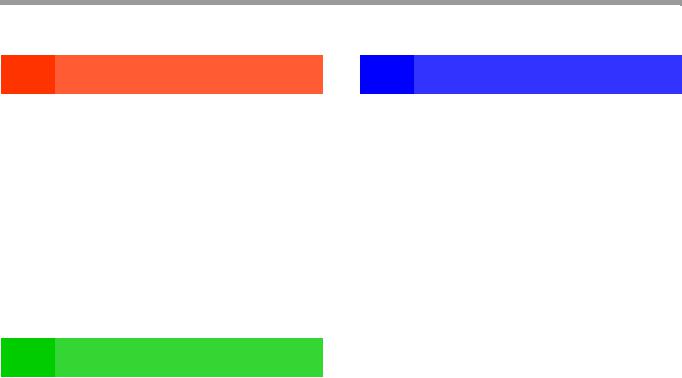
8 |
ROUTINE MAINTENANCE |
|
CHECKING THE TOTAL OUTPUT COUNT AND |
||
TONER LEVEL .............................................. |
120 |
|
• CHECKING THE TOTAL OUTPUT COUNT .... |
120 |
|
• CHECKING THE TONER LEVEL ................. |
121 |
|
ROUTINE MAINTENANCE............................ |
122 |
|
• CLEANING THE DOCUMENT GLASS AND |
|
|
|
RSPF/DOCUMENT COVER......................... |
122 |
• CLEANING THE ORIGINAL SCANNING GLASS |
||
|
(ONLY WHEN AN RSPF IS INSTALLED) ......... |
122 |
• CLEANING THE BYPASS TRAY PAPER FEED |
||
|
ROLLER............................................................ |
123 |
• CLEANING THE ORIGINAL FEED ROLLER ...... |
123 |
|
9 |
APPENDIX |
|
PERIPHERAL DEVICES................................ |
124 |
|
• 500-SHEET PAPER FEED UNIT.................. |
125 |
|
STORAGE OF SUPPLIES ............................. |
126 |
|
• PROPER STORAGE .................................... |
126 |
|
10 WEB FUNCTIONS IN THE MACHINE |
|
ABOUT THE WEB PAGES ........................... |
127 |
• HOW TO ACCESS THE WEB PAGE AND |
|
VIEW HELP ................................................. |
127 |
CHECKING THE IP ADDRESS IN THE WEB |
|
PAGE ............................................................. |
128 |
ABOUT THE WEB PAGES (FOR USERS)........ |
129 |
CONFIGURING THE PRINTER CONDITION |
|
SETTINGS ..................................................... |
130 |
• HOW TO CONFIGURE THE SETTINGS..... |
130 |
• PRINTER CONDITION SETTING MENU .... |
131 |
• PRINTER CONDITION SETTINGS ............. |
131 |
ABOUT THE WEB PAGES (FOR THE |
|
ADMINISTRATOR) ........................................ |
133 |
PROTECTING INFORMATION PROGRAMMED |
|
IN THE WEB PAGE ([Passwords]) .............. |
134 |
ADMINISTRATOR SETTINGS ...................... |
135 |
• CONFIGURING A SETTING IN THE |
|
ADMINISTRATOR SETTINGS .................... |
135 |
• ADMINISTRATOR SETTINGS .................... |
135 |
SSL SETTINGS ............................................. |
136 |
E-MAIL STATUS AND E-MAIL ALERT |
|
SETTINGS ..................................................... |
137 |
• INFORMATION SETUP............................... |
137 |
• SMTP SETUP .............................................. |
137 |
• STATUS MESSAGE SETUP ....................... |
138 |
• ALERTS MESSAGE SETUP ....................... |
138 |
5
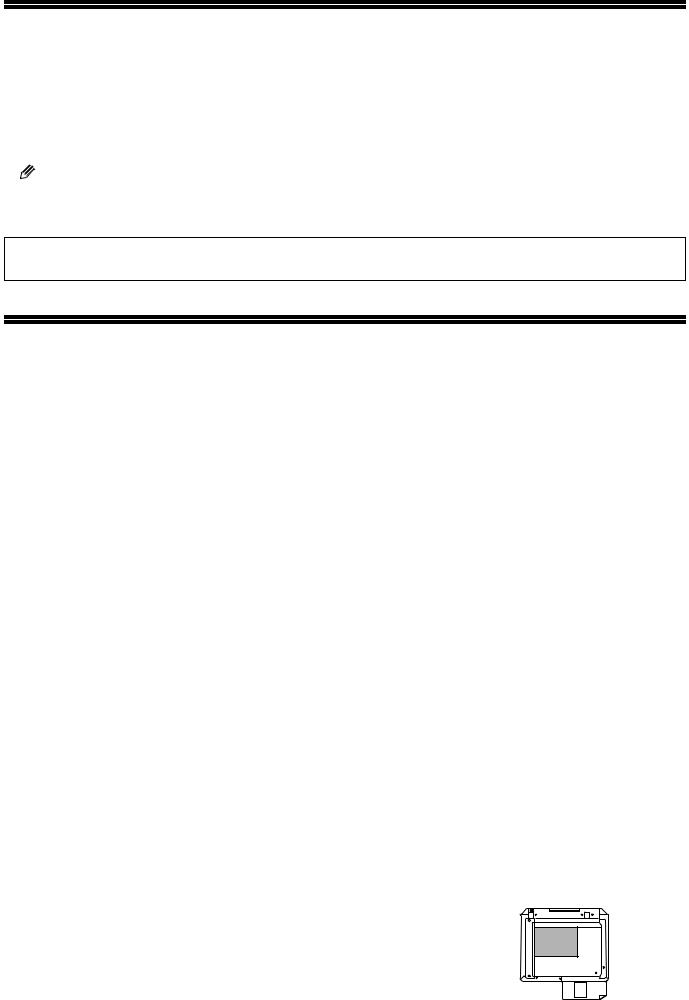
INTRODUCTION
This manual describes the copier, printer, and scanner functions of the AR-6020/AR-6023, AR-6020D/AR-6023D, AR- 6020N/AR-6023N and AR-6026N/AR-6031N digital multifunctional system. And also explains how to configure network settings to enable the machine to be used as a network printer/scanner.
|
|
• |
Where "AR-xxxx" appears in this manual, please substitute the name of your model for "xxxx". For the name of |
|
Note |
|
your model, see "DIFFERENCES BETWEEN MODELS" (p.7). |
|
• |
The screen images and procedures that appear in this manual are mainly for Windows 7. With other versions of |
|
|
|
|
Windows, some screen images may be different from those in this manual. |
|
|
• |
For information on using your operating system, refer to your operating system's manual or online Help. |
|
|
|
|
The display screens, messages, and key names shown in the manual may differ from those on the actual machine due to product improvements and modifications.
USING THE MANUAL
This machine has been designed to provide convenient copying features in a minimum amount of office space and with maximum operational ease. To get full use of all machine features, be sure to familiarise yourself with this manual and the machine. For quick reference during machine use, SHARP recommends printing out this manual and keep it in a handy location.
ABOUT THE MANUALS
The manuals for the machine are as follows:
Start Guide
This manual explains:
•Specifications
•Cautions for using the machine in safety
Operation Guide (this guide)
This manual explains:
•How to install the software that allows the machine to be used as a printer and scanner for your computer
•Part names of the machine
•Available paper type for this machine
•Basic copy procedure and advanced copy functions
(For example: rotating the image 90 degrees, copying multiple originals onto a single sheet of paper)
•Basic print procedure and other frequently used print functions
(For example: fitting the printed image to the paper, enlarging/reducing the print image)
•Scanning on the machine and from a computer
•Toner cartridge replacement and peripheral devices
•Troubleshooting for using the machine
THE MEANING OF "R" IN ORIGINAL AND PAPER SIZE INDICATIONS
An "R" appearing at the end of an original or paper size (A4R
(5-1/2" x 8-1/2"R, 8-1/2" x 11"R), etc.) indicates that the original or paper is oriented horizontally as shown on the right.
Sizes that can be placed only in the horizontal (landscape) orientation (B4, A3 (8-1/2" x 14", 11" x 17")) do not contain the "R" in their size indication.
<Horizontal (Landscape) orientation>
6

CONVENTIONS USED IN THIS MANUAL
|
Warning |
Warns the user that injury may result if the contents of the warning are not properly followed. |
|
|
Cautions the user that damage to the machine or one of its components may result if the contents |
|
|
|
|
Caution |
|
|
of the caution are not properly followed. |
|
|
Note |
Notes provide information relevant to the machine regarding specifications, functions, |
|
performance, operation and such, that may be useful to the user. |
RSPF
This manual refers to the Reversing Single Pass Feeder as the "RSPF".
DIFFERENCES BETWEEN MODELS
This manual covers the following models.
Model |
AR-6020 |
AR-6020D |
AR-6020N |
AR-6026N |
|
AR-6023 |
AR-6023D |
AR-6023N |
AR-6031N |
||
|
|||||
|
|
|
|
|
Appearance
Copy speed |
AR-6020 |
|
20CPM |
AR-6020D |
20CPM |
AR-6020N |
20CPM |
AR-6026N |
26CPM |
|
|
|
|
|
|
|
|
|
|
AR-6023 |
|
23CPM |
AR-6023D |
23CPM |
AR-6023N |
23CPM |
AR-6031N |
31CPM |
|
|
|
||||||||
|
|
|
|
|
|
|
|
|
|
Duplex |
- |
|
|
Standard |
|
|
|||
|
|
|
|
|
|
|
|
|
|
Network function |
|
Optional |
|
|
Standard |
|
|||
|
|
|
|
|
|
|
|
|
|
Paper trays |
|
|
One (250 x 1) |
|
|
Two (500 x 2) |
|||
|
|
|
|
|
|
|
|
|
|
AB series (metric) and inch series references
Both specifications are quoted where applicable.
For example: |
|
Page 6.................................. |
B4 and A3 (8-1/2" x 14" and 11" x 17") |
Start Guide ........................... |
50%, 70%, 81%, 86%, 100%, 115%, 122%, 141%, 200% (50%, 64%, 77%, 95%, |
|
100%, 121%, 129%, 141%, 200%) |
Although AB series size indications are shown on the operation panel of this manual, inch series indications are displayed on the inch series machines.
7

1 |
Chapter 1 |
||
SETUP |
|||
|
|
|
|
|
|
|
|
BEFORE SOFTWARE SETUP
This chapter explains how to install and configure the software that is required for the printer and scanner functions of the machine.
 Note This manual refers to the CD-ROM that accompanied the machine simply as "CD-ROM".
Note This manual refers to the CD-ROM that accompanied the machine simply as "CD-ROM".
SOFTWARE
The CD-ROM that accompanies the machine contains the following software:
AR-6020/AR-6023/AR-6020D/AR-6023D
MFP driver
Printer driver
The printer driver enables you to use the printer function of the machine.
The printer driver includes the Print Status Window. This is a utility that monitors the machine and informs you of the printing status, the name of the document currently being printed, and error messages.
Scanner driver
The scanner driver allows you to use the scanning function of the machine with TWAIN-compliant and WIA-compliant applications.
Button Manager
Button Manager allows you to use the scanner menus on the machine to scan a document.
AR-6020N/AR-6023N/AR-6026N/AR-6031N
Printer driver
The printer driver enables you to use the printer function of the machine.
Scanner driver
The scanner driver allows you to use the scanning function of the machine with TWAIN-compliant software applications.
|
Note |
• |
To use the machine with a USB connection, the printer expansion kit is required. |
|
• |
On a USB connection, the scanner driver cannot be installed. |
|
|
|
|
|
8

SETUP
When the network expansion kit or the printer expansion kit is installed Software for Windows
Printer driver
These allow the machine to be used as a printer.
-PCL6 printer driver
PCL6 printer driver
-PS printer driver*
The PS printer driver supports the PostScript 3 page description language developed by Adobe Systems Incorporated.
-PPD driver*
The PPD driver enables the machine to use the standard Windows PS printer driver. |
1 |
Printer Status Monitor |
This allows you to monitor the status of the machine on your computer screen.
Scanner driver (TWAIN driver)
This allows you to use the scanner function of the machine from a TWAIN-compliant software application.
Software for Macintosh
PPD file*
The printer description file supports the PostScript 3 page description language developed by Adobe Systems Incorporated.
* The PS3 expansion kit is required.
HARDWARE AND SOFTWARE REQUIREMENTS
Check the following hardware and software requirements before installing the software.
|
|
|
AR-6020/AR-6023/AR-6020D/AR-6023D*1 |
AR-6020N/AR-6023N/AR-6026N/AR-6031N*2 |
|
|
|
|
IBM PC/AT or compatible computer equipped |
IBM PC/AT or compatible computer equipped |
|
Computer type |
with a 10BASE-T/100BASE-TX LAN |
||||
with a USB 2.0*3/1.1*4 |
|||||
|
|
|
connector |
||
|
|
|
|
||
|
|
|
|
|
|
|
|
|
Windows Vista, Windows 7, Windows 8 |
Windows Vista, Windows 7, Windows 8, |
|
|
|
Printer |
Windows server 2003*6, Windows server |
Windows server 2003, Windows server 2008, |
|
|
|
driver |
2008*6, Windows server 2012*6 |
Windows server 2012 |
|
Operating |
|
Mac OS X 10.4 to 10.9*6,*7 |
Mac OS X 10.4 to 10.9*7 |
||
system*5 |
|
Windows Vista, Windows 7, Windows 8 |
Windows Vista, Windows 7, Windows 8, |
||
|
|
Scanner |
Windows server 2003*6, |
Windows server 2003, Windows server 2008, |
|
|
|
driver |
Windows server 2008*6, |
Windows server 2012 |
|
|
|
|
Windows server 2012*6 |
|
|
Other hardware requirements |
An environment on which any of the operating systems listed above can fully operate |
||||
|
|
|
|
|
|
*1 |
When the network expansion kit is installed, 10BASE-T/100BASE-TX LAN functions can be used. |
||||
*2 |
When the machine is connected using a USB cable, it cannot be used as a printer. To use the machine as a printer with a USB |
||||
*3 |
connection, the printer expansion kit is required. |
|
|||
The machine's USB 2.0 port will transfer data at the speed specified by the USB 2.0 (Hi-Speed) only if the Microsoft USB 2.0 |
|||||
|
driver is preinstalled in the computer, or if the USB 2.0 driver for Windows Vista/7/8, Windows server 2003/2008/2012 that |
||||
*4 |
Microsoft provides through its "Windows Update" is installed. |
|
|||
Compatible with Windows Vista, or Windows 7, Windows 8, |
|
||||
*5 |
Windows server 2003, Windows server 2008, Windows server 2012 preinstalled models equipped with a USB interface as standard. |
||||
• The machine does not support printing from a Macintosh environment. |
|
||||
*6 |
• Administrator’s rights are required to install the software using the installer. |
|
|||
The network expansion kit is required. |
|
||||
*7 |
The PS3 expansion kit is required. |
|
|||
9

INSTALLING THE SOFTWARE
•AR-6020/AR-6023/AR-6020D/AR-6023D: this page
•AR-6020N/AR-6023N/AR-6026N/AR-6031N: page 14
•When the network expansion kit or the printer expansion kit is installed : page 14
• |
The screen images in this manual are mainly for Windows 7. With other versions of Windows, some screen |
Note |
images may be different from those in this manual. |
•If an error message appears, follow the instructions on the screen to solve the problem. After the problem is solved, the installation procedure will continue. Depending on the problem, you may have to click the "Cancel" button to exit the installer. In this case, reinstall the software from the beginning after solving the problem.
AR-6020/AR-6023/AR-6020D/AR-6023D
1 The USB cable must not be connected to the machine. Make sure that the cable is not connected before proceeding.
If the cable is connected, a Plug and Play window will appear. If this happens, click the "Cancel" button to close the window and disconnect the cable.
 Note The cable will be connected in step 12.
Note The cable will be connected in step 12.
2 Insert the CD-ROM into your CD-ROM drive.
3 Click the "Start" button ( ), click "Computer", and then double-click the "CD-ROM" icon (
), click "Computer", and then double-click the "CD-ROM" icon (  )
)
In Windows 8, double-click the "CD-ROM" icon.
*If no icon is displayed, right-click in the Start screen (or swipe upward from the bottom edge), then select the App Bar Þ "All apps" Þ "Computer" and then double-click "CD-ROM".
4 Double-click the "Setup" icon ( ).
).
• |
In Windows 7/8, if a message screen |
Caution |
appears asking you for confirmation, click |
|
"Yes". |
•In Windows Vista, if a message screen appears asking you for confirmation, click "Allow".
5 The "SOFTWARE LICENSE" window will appear. Make sure that you understand the contents of the software license, and then click the "Yes" button.
You can show the "SOFTWARE LICENSE" in Note a different language by selecting the desired language from the language menu. To install
the software in the selected language, continue the installation with that language selected.
6 Read the message in the "Welcome" window and then click the "Next" button.
7 To connect the machine and a computer directly via a USB cable, normally click the "Standard" button and go to step 11. When you click the "Custom" button, go to the next step.
To automatically install the MFP driver (printer/scanner driver) and Button Manager, select “Standard”.
8 Click the "MFP Driver" button.
Click the "Display Readme" button to show information on packages that are selected.
10
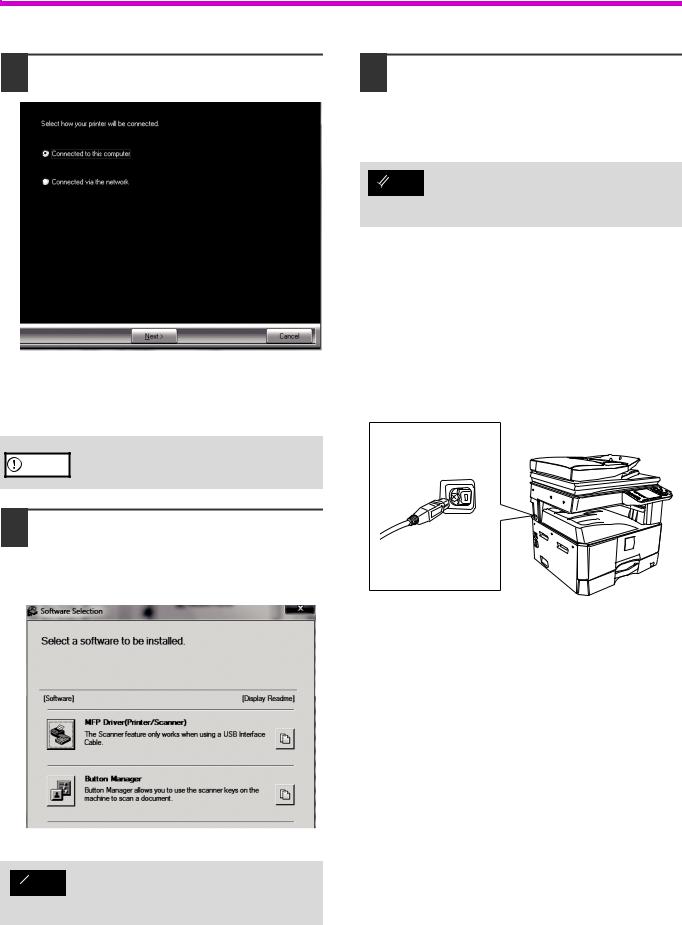
SETUP
9 Select "Connected to this computer" and click the "Next" button.
Follow the on-screen instructions.
When "The installation of the SHARP software is complete." appears, click the "OK" button and go to the next step.
|
If you are using Windows Vista/7/8 |
Caution |
If a security warning window appears, be sure |
|
to click "Install this driver software anyway". |
10 You will return to the window of step 8. If you wish to install Button Manager, click the "Button Manager" button.
If you do not wish to install the Button Manager, go to step 11.
11 When installing is finished, click the "Close" button.
A message will appear instructing you to connect the machine to your computer. Click the "OK" button.
After the installation, a message prompting Note you to restart your computer may appear. In
this case, click the "Yes" button to restart your computer.
|
|
|
|
1 |
12 |
Connect the machine to your |
|||
computer with a USB cable. |
||||
|
(1) |
Make sure that the machine is powered |
|
|
|
|
on. (p.37) |
|
|
|
(2) |
Connect the cable to the USB connector |
|
|
|
|
(B type) on the machine. |
|
|
The USB interface on the machine complies with the USB 2.0 (Hi-Speed) standard. Please purchase a shielded USB cable.
(3)Connect the other end of the cable to the USB connector (A type) on your computer.
Follow the on-screen instructions.
After the installation, a message prompting  Note you to restart your computer may appear. In
Note you to restart your computer may appear. In
this case, click the "Yes" button to restart your computer.
11

SETUP
13 Follow the instructions in the Plug and Play window to install the driver.
Follow the on-screen instructions.
Caution |
If you are using Windows Vista/7/8
If a security warning window appears, be sure to click "Install this driver software anyway".
This completes the installation of the software.
System requirements for USB 2.0 (Hi-Speed mode)
•The machine's USB 2.0 connector will transfer data at the speed specified by the USB 2.0 (Hi-Speed) only if the Microsoft USB 2.0 driver is preinstalled in the computer, or if the USB 2.0 driver for Windows Vista/7/8, Windows server 2003/2008/2012 that Microsoft provides through its "Windows Update" Web page is installed.
•Even when the Microsoft USB 2.0 driver is used, it may not be possible to obtain full USB 2.0 speed if a PC card supporting USB 2.0 is used. To obtain the latest driver (which may enable a higher speed), contact the manufacturer of your PC card.
•Connection is also possible using a USB 1.1 port on your computer. However, the specifications will be USB 1.1 specifications (Full-Speed).
•If your computer is not compatible with USB 2.0 (Hi-Speed), the "USB 2.0 mode switching" setting in the machine's system setting must be set to "Full-Speed". For more information, see "SYSTEM SETTINGS" (p.91).
12

SETUP
USING THE MACHINE AS A SHARED PRINTER
If the machine will be used as a shared printer on a Windows network, follow these steps to install the printer driver in the client computer.
To configure the appropriate settings in the print server, see the operation manual or help file of your operating 
 Note system.
Note system.
1 Perform steps 2 through 6 in "INSTALLING THE SOFTWARE" (p.10).
2 Click the "Custom" button.
3 Click the "MFP Driver" button.
Click the "Display Readme" button to show information on packages that are selected.
4 Select "Connected via the network" and click the "Next" button.
5 Click the part you want to use with this printer.
(1) |
Select the MFP port. |
1 |
|||
(2) |
Click the "Next" button. |
||||
|
|||||
|
|
|
|
||
6 |
Click the "Next" button. |
|
|||
|
Follow the on-screen instructions. |
|
|||
|
|
||||
|
Note |
If the shared printer does not appear in the |
|
||
|
list, check the settings on the print server. |
|
|||
|
If you are using Windows Vista/7/8 |
Caution |
If a security warning window appears, be sure |
|
to click "Install this driver software anyway". |
7 When the installation completed screen appears, click the "OK" button.
8 Click the "Close" button in the window of step 3.
After the installation, a message prompting  Note you to restart your computer may appear. In
Note you to restart your computer may appear. In
this case, click the "Yes" button to restart your computer.
This completes the installation of the software.
13
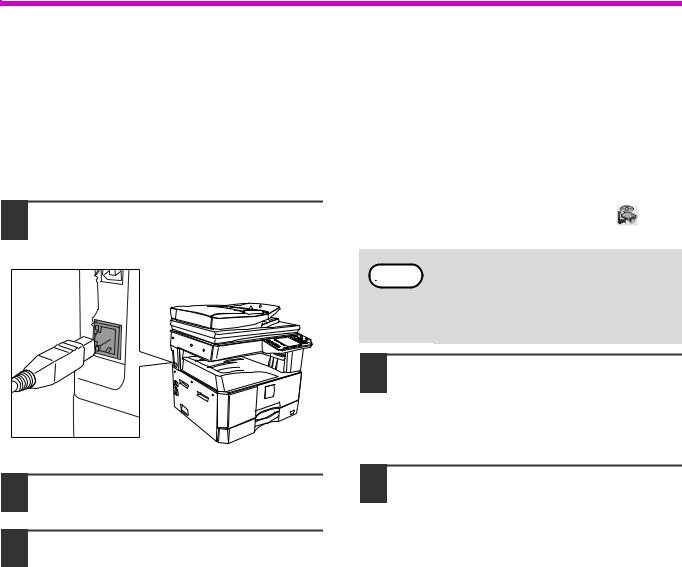
SETUP
FOR A MODEL THAT HAS THE NETWORK FUNCITON AS A STANDARD FEATURE OR WHEN THE NETWORK EXPANSION KIT IS INSTALLED
Installing the printer driver
When the machine is connected to a network
1 Insert the LAN cable into the LAN connector on the machine.
Use a network cable that is shielded.
2 Insert the CD-ROM into your CD-ROM drive.
3 Click the "Start" button ( ), click "Computer", and then double-click the "CD-ROM" icon (
), click "Computer", and then double-click the "CD-ROM" icon (  ).
).
•In Windows Server 2003/2008, click the "start" button, click "My Computer", and then double-click the "CD-ROM" icon.
•In Windows 8/Server 2012, double-click the "CD-ROM" icon.
*If no icon is displayed, right-click in the Start screen (or swipe upward from the bottom edge), then select the App Bar Þ "All apps" Þ "Computer" and then double-click "CD-ROM".
4 |
Double-click the "Setup" icon ( |
). |
|
|
|
• In Windows 7/8/Server 2012, if a message  Note screen appears asking you for confirmation,
Note screen appears asking you for confirmation,
click "Yes".
• In Windows Vista/Server 2008, if a message screen appears asking you for confirmation, click "Allow".
5 The "SOFTWARE LICENSE" window will appear. Make sure that you understand the contents of the software license, and then click the "Yes" button.
6 Read the message in the "Welcome" window and then click the "Next" button.
14
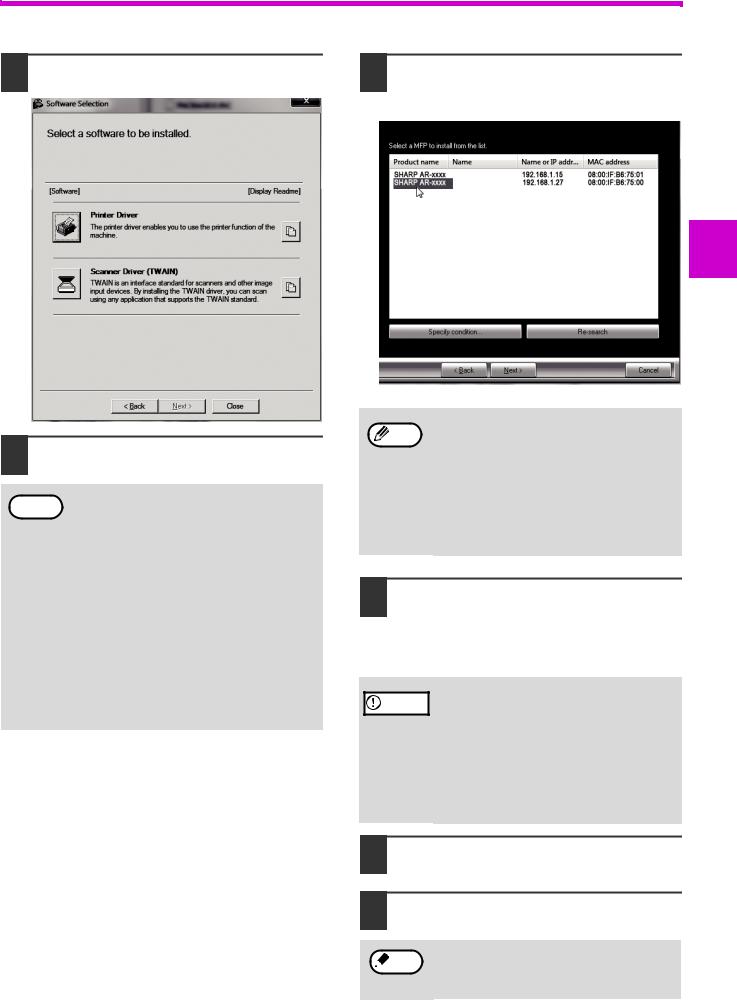
SETUP
7 Click the "Printer Driver" button.
9 Printers connected to the network are detected. Select the machine and click the "Next" button.
1
8 Click the "Standard installation" button.
When "Custom installation" is selected, you  Note can change any of the items below. When
Note can change any of the items below. When
"Standard installation" is selected, the installation will take place as indicated below.
• Machine connection method:
LPR Direct Print (Auto Search)
• Set as default printer: Yes
• Printer driver name:
Cannot be changed
• PCL printer display fonts (Only at the time of PCL, PS printer driver or PPD driver installation): Installed.
If you selected "Custom installation", select "LPR Direct Print (Auto Search)" and click the "Next" button.
• |
This screen is not displayed when only 1 |
Note |
device is found in the search results. |
• |
If the machine is not found, make sure that |
the machine is powered on and that the machine is connected to the network, and then click the "Re-search" button.
• You can also click the "Specify condition" button and search for the machine by entering the machine's name (host name) or IP address.
10 Follow the on-screen instructions.
Read the message in the window that appears and click the "Next" button.
Installation begins.
Caution |
•If you are using Windows Vista/Server 2008/7/8 /Server 2012
If a security warning window appears, be sure to click "Install this driver software anyway".
•If you are using Windows Server 2003
If a warning message regarding the Windows logo test or digital signature appears, be sure to click the "Continue Anyway" or "Yes" button.
11 When the installation completed screen appears, click the "OK" button.
12 Click the "Close" button in the window of step 7.
After the installation, a message prompting  Note you to restart your computer may appear.
Note you to restart your computer may appear.
If this message appears, click the "Yes" button to restart your computer.
15
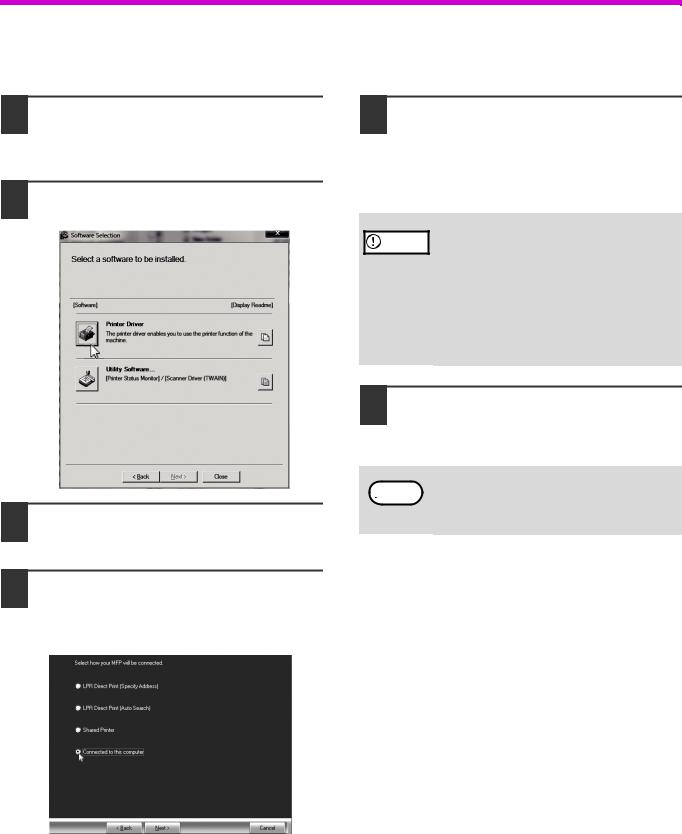
SETUP
When the machine will be connected with a USB cable
(When the network expansion kit or the printer expansion kit is installed)
1 Perform steps 2 through 6 in "When the machine is connected to a network" (p.14).
2 Click the "Printer Driver" button.
3 Click the "Custom installation" button.
4 When you are asked how the printer is connected, select "Connected to this computer" and click the "Next" button.
5 Follow the on-screen instructions.
Read the message in the window that appears and click the "Next" button.
When the installation completed screen appears, click the "OK" button.
Caution |
•If you are using Windows Vista/Server 2008/7/8 /Server 2012
If a security warning window appears, be sure to click "Install this driver software anyway".
•If you are using Windows Server 2003
If a warning message regarding the Windows logo test or digital signature appears, be sure to click the "Continue Anyway" or "Yes" button.
6 Click the "Close" button in the window of step 2.
When a message appears prompting you to connect the machine to your computer, click the "OK" button.
After the installation, a message prompting  Note you to restart your computer may appear. If
Note you to restart your computer may appear. If
this message appears, click the "Yes" button to restart your computer.
16
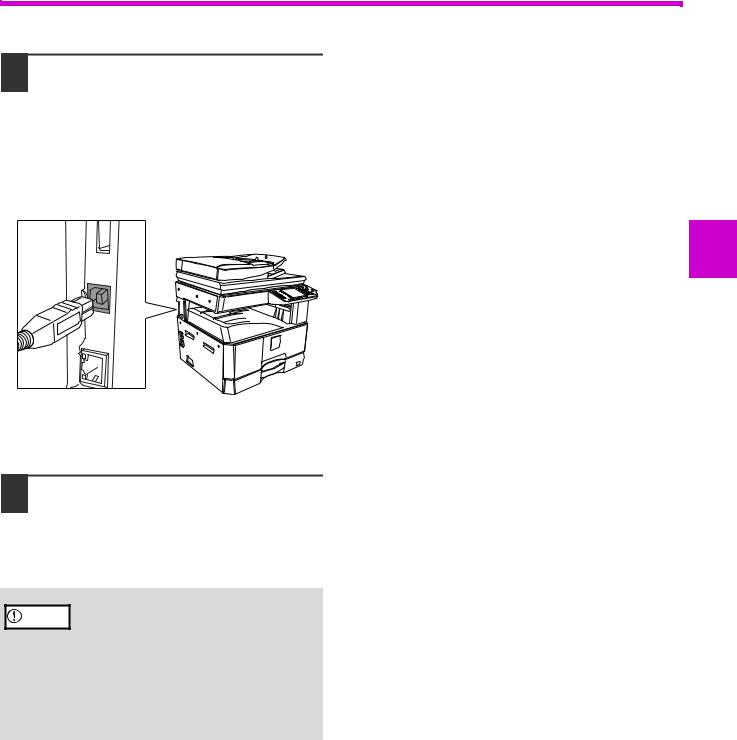
SETUP
7 Connect the machine to your computer with a USB cable.
(1)Make sure that the machine is powered on. (p.37)
(2)Connect the cable to the USB connector (B type) on the machine.
The USB interface on the machine complies with the USB 2.0 (Hi-Speed) standard. Please purchase a shielded USB cable.
1
(3)Connect the other end of the cable to the USB connector (A type) on your computer.
8 Installation of the PCL6 printer driver begins.
When the "Found New Hardware Wizard" appears, select "Install the software automatically (Recommended)", click the "Next" button, and follow the on-screen instructions.
Caution |
•If you are using Windows Vista/Server 2008/7/8/Server 2012
If a security warning window appears, be sure to click "Install this driver software anyway".
•If you are using Windows Server 2003
If a warning message regarding the Windows logo test or digital signature appears, be sure to click the "Continue Anyway" or "Yes" button.
This completes the installation.
17

SETUP
When installing the PS printer driver or PPD driver
Installation is possible even after the USB cable has been connected.
1 Click the "Printer Driver" button.
2 Click the "Custom installation" button.
3 When you are asked how the printer is connected, select "LPR Direct Print (Specify Address)" and click the "Next" button.
When selecting "Connected to this computer",  Note the PS printer driver or PPD driver can not be
Note the PS printer driver or PPD driver can not be
installed. Only selecting excluded from "Connected to this computer" can go to step 5.
4 When the model selection window appears, select the model that you want to use and click the "Next" button.
5 When the printer driver selection window appears, remove the "PCL6" checkmark and select the printer driver to be installed, and then click the "Next" button.
Click the checkbox of the printer driver to be installed so that a checkmark (  ) appears.
) appears.
Note |
The PS3 expansion kit is required to use the |
PS printer driver or the PPD driver. |
6 Follow the on-screen instructions.
Read the message in the window that appears and click the "Next" button.
Installation begins.
Caution |
•If you are using Windows Vista/Server 2008/7/8/Server 2012
If a security warning window appears, be sure to click "Install this driver software anyway".
•If you are using Windows Server 2003
If a warning message regarding the Windows logo test or digital signature appears, be sure to click the "Continue Anyway" or "Yes" button.
7 When the installation completed screen appears, click the "OK" button.
8 Click the "Close" button in the window of step 1.
After the installation, a message prompting  Note you to restart your computer may appear. If
Note you to restart your computer may appear. If
this message appears, click the "Yes" button to restart your computer.
This completes the installation.
18

SETUP
Installing the printer status monitor
(when the network expansion kit or the printer expansion kit is installed)
Printer Status Monitor is a printer utility that allows general users to check the current status of the machine on their computer screen, such as whether or not the machine is ready to print. The Printer Status Monitor shows error information such as paper misfeeds, printer configuration information as an image, the paper sizes that can be used, and the amount of paper remaining.
Administrator's rights are required to install the software.
Note |
The Printer Status Monitor cannot be used in the following situations: |
• When the machine is connected by a USB cable. |
1 Click the "Utility Software" button and then click the "Printer Status Monitor" button.
1
4 Click the "Close" button in the window of step 1.
After the installation, a message prompting  Note you to restart your computer may appear. If this message appears, click the "Yes" button
Note you to restart your computer may appear. If this message appears, click the "Yes" button
to restart your computer.
This completes the installation.
For the procedures for using the Printer Status Monitor, see the Help file. Follow these steps to view the Help file: Click the Windows "start" button, select "All Programs", select "SHARP Printer Status Monitor" and then select "Help".
In Windows 8/Server 2012, right-click in the startup window (or swipe upward from the bottom edge), then select "Taskbar" → "All Applications" → "Help" in the SHARP Printer Status Monitor menu.
2 Follow the on-screen instructions.
3 When the installation completed screen appears, click the "Finish" button.
To have the Printer Status Monitor start automatically when your computer is started, select the "Add this program to your Startup folder" checkbox  and click the "Finish" button.
and click the "Finish" button.
19

SETUP
Installing the scanner driver
1 Perform steps 2 through 6 in "When the machine is connected to a network" (p.14).
2 Click the "Scanner Driver (TWAIN) " button.
If the network expansion kit or the printer expansion kit is installed, click the "Utility Software" button and then click "Scanner Driver (TWAIN)".
6 Click the "start" button, select "All Programs", select "SHARP MFP TWAIN AC" ("SHARP MFP TWAIN K" on a network connection), and then select "Select Device".
7 Click the "Search" button.
If you know the IP address, you can click the "Input" key and enter the IP address without searching.
3 Follow the on-screen instructions.
Read the message in the window that appears and click the "Yes" button.
4 When the finish setup window appears, click the "OK" button.
5 Click the "Close" button in the window of step 2.
After the installation, a message prompting  Note you to restart your computer may appear. If this message appears, click the "Yes" button
Note you to restart your computer may appear. If this message appears, click the "Yes" button
to restart your computer.
This completes the installation. Next, configure the IP address of the machine in the scanner driver.
When the scanner driver is installed, the "Select Device" utility is also installed.
The IP address of the machine is configured in the scanner driver using "Select Device".
20

8 Select the IP address of the machine from the "Address" menu and click the "OK" button.
•Be sure to ask your system administrator (network administrator) for the IP address of the machine.
•The name (host name) or IP address of the machine can be directly entered in "Address".
•If the port number used by the scanner function of the machine has been changed, enter a colon ":" following the IP address and then enter the port number. (Normally the port number does not need to be entered.)
AR-xxxx
9 Click the "OK" button.
AR-xxxx
This completes the configuration of the scanner driver.
SETUP
1
21

SETUP
INSTALLING THE PS DISPLAY FONTS
Fonts that can be used by the PS printer driver are contained on the "PRINTER UTILITIES" CD-ROM that accompanies the PS3 expansion kit. Install these fonts as needed for the PS printer driver.
 Note Tokit.install on Mac OS, see ReadMe on the “PRINTER UTILITIES" CD-ROM that is included in the PS3 expansion
Note Tokit.install on Mac OS, see ReadMe on the “PRINTER UTILITIES" CD-ROM that is included in the PS3 expansion
1 Insert the "PRINTER UTILITIES" CD-ROM that accompanies the PS3 expansion kit into your computer's CD-ROM drive.
2 Click the "Start" button ( ), click "Computer", and then double-click the "CD-ROM" icon (
), click "Computer", and then double-click the "CD-ROM" icon (  )
)
In Windows 8, double-click the "CD-ROM" icon. *If no icon is displayed, right-click in the Start screen (or swipe upward from the bottom edge), then select the App Bar Þ "All apps" Þ
"Computer" and then double-click "CD-ROM".
3 Double-click the "Setup" icon ( ).
).
• In Windows 7/8/Server 2012, if a message  Note screen appears asking you for confirmation,
Note screen appears asking you for confirmation,
click "Yes".
•In Windows Vista/Server 2008, if a message screen appears asking you for confirmation, click "Allow".
4 The "SOFTWARE LICENSE" window will appear. Make sure that you understand the contents of the license agreement and then click the "Yes" button.
You can show the "SOFTWARE LICENSE" in  Note a different language by selecting the desired language from the language menu. To install
Note a different language by selecting the desired language from the language menu. To install
the software in the selected language, continue the installation with that language selected.
5 Read the message in the "Welcome" window and then click the "Next" button.
6 Click the "PS Display Font" button.
7 Follow the on-screen instructions.
8 Click the "Close" button in the screen of step 6.
22
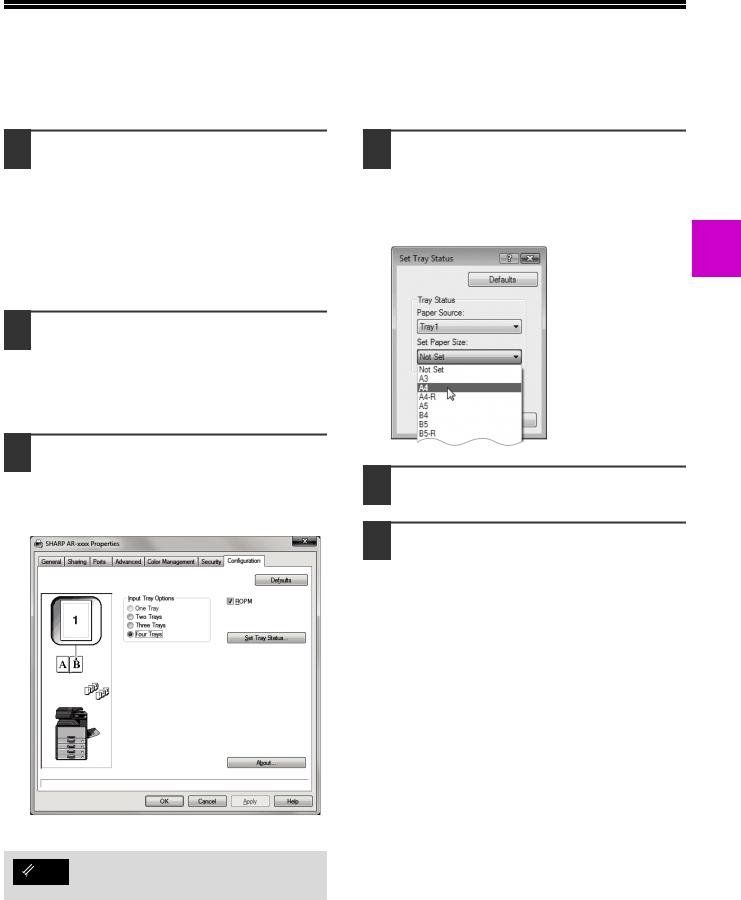
CONFIGURING THE PRINTER DRIVER
After installing the printer driver, you must configure the printer driver settings appropriately for the number of paper trays on the machine and the size of paper loaded in each.
1 Click the "Start" button and then click "Devices and Printers".
•In Windows Server 2003, click the "start" button and then click "Printers and Faxes".
•For Windows 8, right-click in the Start screen (or swipe upward from the bottom edge), then click the App Bar Þ "All apps" Þ "Control Panel" Þ "Hardware and Sound" Þ "Devices and Printers" Þ "Printers".
2 Right-click the "SHARP AR-xxxx" printer driver icon, and then click "Printer properties".
In Windows Vista click the "SHARP AR-xxxx" printer driver icon and select "Properties" from the "Organize" menu.
3 Click the "Configuration" tab and set the printer configuration based on the options that have been installed.
Set the printer configuration properly. If not, printing may not take place correctly.
4 Click the "Set Tray Status" button and select the size of paper that is loaded in each tray.
Select a tray in the "Paper Source" menu, and select the size of paper loaded in that tray from
the "Set Paper Size" menu. Repeat for each tray. 1
5 Click the "OK" button in the "Set Tray Status" window.
6 Click the "OK" button in the printer properties window.
For the PCL Driver, to configure the settings Note automatically based on the detected machine
status, click the "Auto Configuration" button.
23

SETTING UP BUTTON MANAGER
(For AR-6020/AR-6023/AR-6020D/AR-6023D)
Button Manager is a software program that works with the scanner driver to enable scanning from the machine.
To scan using the machine, Button Manager must be linked with the scan menu on the machine. Follow the steps below to link Button Manager to scanner events .
1 Click the "Start" button and then click "Devices and Printers".
•In Windows Vista click the "Start" button, click "Control Panel", click "Hardware and Sound", and then click "Scanners and Cameras".
•For Windows 8, right-click in the Start screen (or swipe upward from the bottom edge), then click the App Bar Þ "All apps" Þ "Control Panel" Þ "Hardware and Sound" Þ "Devices and Printers" Þ "Printers".
2 Right-click the "SHARP AR-xxxx" icon and select "Scan properties".
In Windows Vista click the "SHARP AR-xxxx" icon and select "Properties".
3 In the "Properties" screen, click the "Events" tab.
4 Select "ScanMenu SC1:" from the "Select an event" pull-down menu.
ScanMenu SC1:
5 Select "Start this program" and then select "Sharp Button Manager AC" from the pull-down menu.
ScanMen SC1:
6 Repeat Steps 4 and 5 to link Button Manager to "ScanMenu SC2:" through "ScanMenu SC6:".
Select "Scanmenu SC2:" from the "Select an event" pull-down menu. Select "Start this program", select "Sharp Button Manager AC" from the pull-down menu. Do the same for each scan menu through "Scanmenu SC6:".
7 Click the "OK" button.
Button Manager is now linked to the scan menu (1 through 6).
The scan settings for each of scan menu 1 through 6 can be changed with the setting window of Button Manager.
For the factory default settings of the scan menu and the procedures for configuring Button Manager settings, see "BUTTON MANAGER SETTINGS" (p.81).
24
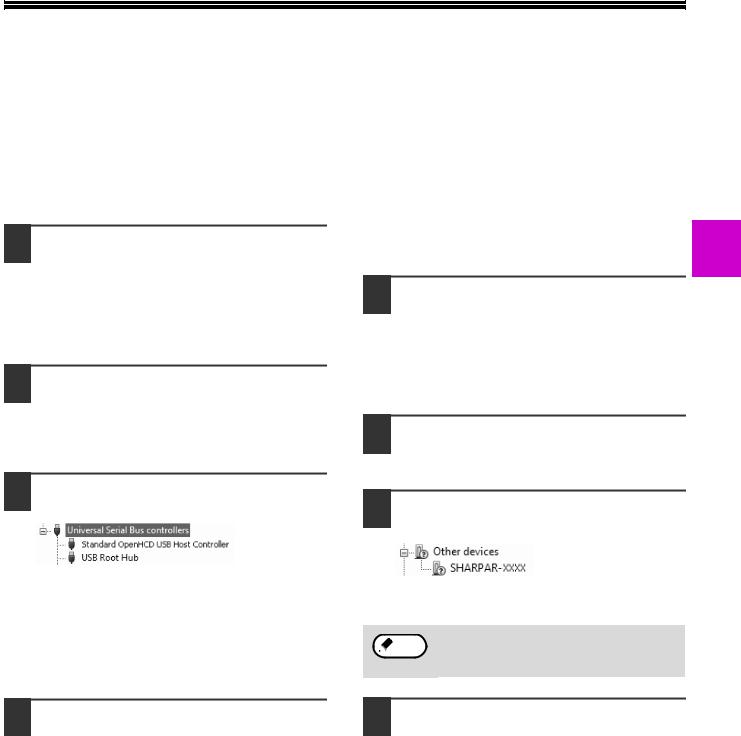
TROUBLESHOOTING
If the software is not installed correctly, check the following items on your computer.
Plug and Play window does not appear
If the Plug and Play window does not appear after you connect the machine to your computer with a USB cable and turn on the machine, follow the steps below to verify that the USB port is available.
1 Click the "Start" button, select "Control Panel", and then click "System".
For Windows 8, right-click in the Start screen (or swipe upward from the bottom edge), then click the App Bar Þ "All apps" Þ "Control Panel" Þ "Hardware and Sound" Þ "Devices Manager" .
2 Click "Device Manager", and if a message screen appears asking you for confirmation, click "Continue".
"Universal Serial Bus controllers" will appear in the list of devices.
3 Click the  icon beside "Universal Serial Bus controllers".
icon beside "Universal Serial Bus controllers".
Two items should appear: your controller chipset type and Root Hub. If these items appear, you can use the USB port. If the "Universal Serial Bus controllers" shows a yellow exclamation point or does not appear, you must check your computer manual for USB troubleshooting or contact your computer manufacturer.
4 Once you have verified that the USB port is enabled, install the software as explained in "INSTALLING THE SOFTWARE" (p.10).
The driver cannot be correctly installed by Plug and Play
If the driver cannot be correctly installed by Plug and Play (for example, Plug and Play takes place without copying the required files for the driver installation), follow these steps to remove unneeded devices and
then install the driver as explained in "INSTALLING 1 THE SOFTWARE" (p.10).
1 Click the "Start" button, select "Control Panel", and then click "System and Maintenance".
For Windows 8, right-click in the Start screen (or swipe upward from the bottom edge), then click the App Bar Þ "All apps" Þ "Control Panel" Þ "Hardware and Sound" Þ "Devices Manager" .
2 Click "Device Manager", and if a message screen appears asking you for confirmation, click "Continue".
3 Click the  icon beside "Other devices".
icon beside "Other devices".
If "SHARP AR-xxxx" appears, select and delete the item.
 Note If "Other devices" does not appear, close the "Device Manager" window.
Note If "Other devices" does not appear, close the "Device Manager" window.
4 Install the software as explained in "INSTALLING THE SOFTWARE" (p.10).
25

SETUP
Removing the software
If you need to remove the software, follow these steps.
1 Click the "start" button and then click "Control Panel".
In Windows 8/Server 2012, right-click in the startup window (or swipe upward from the bottom edge), then select "Taskbar" Þ "All Applications" Þ "Control Panel".
2 Click "Program and Function".
In Windows Server 2003, click "Add or Remove Programs".
3 Select the program or driver that you wish to delete.
For more information, see the manual for the operating system or Help.
4 Restart your computer.
26

SETUP IN A MACINTOSH
ENVIRONMENT
This chapter explains how to install the PPD file to enable printing from a Macintosh and how to configure the printer driver settings.
•The printer expansion kit and PS3 expansion kit are required to use the machine as a printer in a Macintosh environment. In addition, the machine must be connected to a network. A USB connection cannot be used.
•The scanner driver driver cannot be used in a Macintosh environment.
MAC OS X
1
Note |
The explanations of screens and procedures are primarily for Mac OS X v10.8. The screens may vary in other |
versions of the operating system. |
1 Insert the "Software CD-ROM" into your computer's CD-ROM drive.
2 Double-click the "CD-ROM" icon ( ) on the desktop.
) on the desktop.
3 Double-click the "MacOSX" folder.
Before installing the software, be sure to read "ReadMe First". "ReadMe First" is in the "US-English" folder ("English" folder in areas other than the U.S.) in the "Readme" folder
4 Double-click the folder corresponding to the versions of the operating system.
5 Double-click the "SH-L01" icon ( ).
).
6 Click the "Continue" button.
27

SETUP
7 The License Agreement window will appear. Make sure that you understand the contents of the license agreement and then click the "Continue" button.
A message will appear asking you if you agree to the terms of the license. Click the "Agree" button.
• If the license appears in the different  Note language, change the language in the
Note language, change the language in the
language menu.
•In Mac OS X v10.4 to 10.7, select the hard drive and click the "Install" button. Be sure to select the hard drive on which your operating system is installed.
In Mac OS X v10.5 to 10.7, you click the "Change Install Location" button if you change the hard drive which the printer driver is installed.
8 Click the "Install" button.
Installation begins.
If the "Authenticate" window appears, enter  Note the password and click the "Install Software"
Note the password and click the "Install Software"
button.
In Mac OS X v10.4 to 10.6, enter the password and click the "OK" button.
9 When the installation completed screen appears, click the "Close" button.
This completes the installation of the software. Next, configure the printer driver settings.
10 Click "System Preference" in the
Apple menu ( ) and select "Print &
) and select "Print &
Scan" ( ).
).
•If you are using Mac OS X v10.5 to 10.6, click
"System Preferences" in the Apple menu ( ) and select "Print & Fax" (
) and select "Print & Fax" ( ).
).
•In Mac OS X v10.4, select "Utilities" from the "Go" menu and double-click the "Printer Setup
Utility"( )*.
)*.
When the screen for adding a printer appears, click "Add" and then go to step 12.
*If this is the first time you are installing a printer driver on your computer, a confirmation message will appear. Click the "Add" button.
11 Click the  button and select "XXXX".
button and select "XXXX".
In Mac OS X v10.5 to 10.7, when the screen for adding a printer appears, click the  button.
button.
28
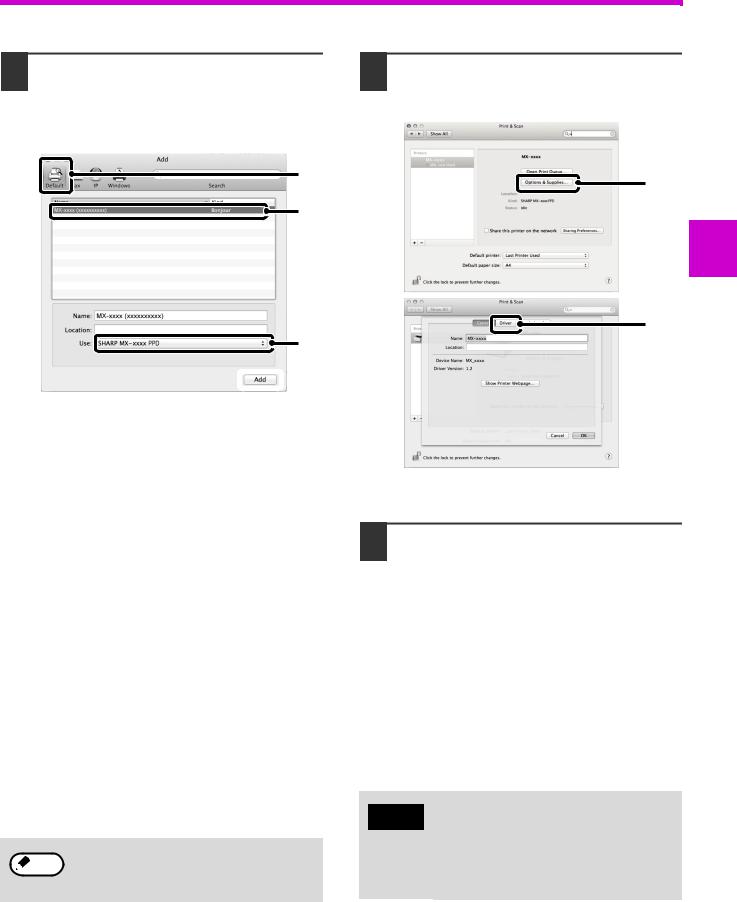
SETUP
12 Configure the printer driver.
If you wish to use the IPP function, see "Printing using the IPP function" (p.30) to configure the printer driver settings.
(1)
(2)
(3)
 (4)
(4)
1Click the "Default" icon.
If you are using Mac OS X v10.4, click the "Default Browser" icon.
2Click the machine's model name.
•Using with AppleTalk:
The machine's model name usually appears as "SCxxxxxx"*.
•Using with Bonjour:
The machine's model name usually appears as
"xxxxxx"*.
*"xxxxxx" is a sequence of characters that varies depending on your model.
3Make sure that the PPD file of your model is selected.
The PPD file of the machine is automatically selected.
4Click the "Add" button.
•Using with AppleTalk:
The PPD file of the machine is automatically selected and the peripheral devices installed on the machine are detected and automatically configured.
•Using with Bonjour:
The "Installable Options" screen appears. Select the machine configuration and click the "Continue" button.
The PPD file is installed in the following  Note folders on the startup disk.
Note folders on the startup disk.
"Library" - "Printers" - "PPDs" - "Contents" - "Resources" - "en.lproj"
13 Click the "Option & Supplies" button and click the "Driver" tab.
(1)
1
(2)
In Mac OS X v10.4, click the machine's name and click the "Show Info" icon.
14 Select the machine configuration.
If you selected "Auto Select" in (3) of step 12, the machine configuration is detected and automatically configured. Check the configured settings to make sure they are correct.
1Select the options that are installed on the machine.
In Mac OS X v10.4, before you are selecting the option, select "Installable Options".
2Click the "OK" button.
If you are using Mac OS X v10.4, click the "Apply Changes" button.
3Click to close the window.
You can check the options that are installed
 Note on the machine by printing out the "All Custom Setting List". (However, note that
Note on the machine by printing out the "All Custom Setting List". (However, note that
"Input Tray Options" must be set to the number of trays on the machine.) To print out the "All Custom Setting List", see the Operation Guide.
This completes the configuration of the printer driver.
29

SETUP
Printing using the IPP function
The machine can print using the IPP function. When the machine is in a remote location, this function can be used in place of the fax function to print a higher quality image than a fax. If you wish to use the IPP function, follow these steps to select the PPD file when configuring the printer driver (step 12 on page 29).
This function can be used on network function standard models and on models with the network expansion kit Note installed.
(1)
(2)
(3)
 (4)
(4)
1Click the "IP" icon.
If you are using Mac OS X v10.4, click the "IP Printer" icon.
2Select "Internet Printing Protocol" in "Protocol". Enter the address of the machine (IP address or domain name) and the queue name.
Enter "ipp" in "Queue".
3Select "Select a driver to use" (or "Select Printer Software") from "Print Using" and click the PPD file for your model.
If you are using Mac OS X v 10.5 to 10.7, select "Sharp" in "Print Using" and click the PPD file of your model.
4Click the "Add" button.
The screen for the machine configuration appears. Make sure that the settings are correct and click the "OK" button.
If you are using Mac OS X v10.5 to 10.6, click the "Continue" button.
30
